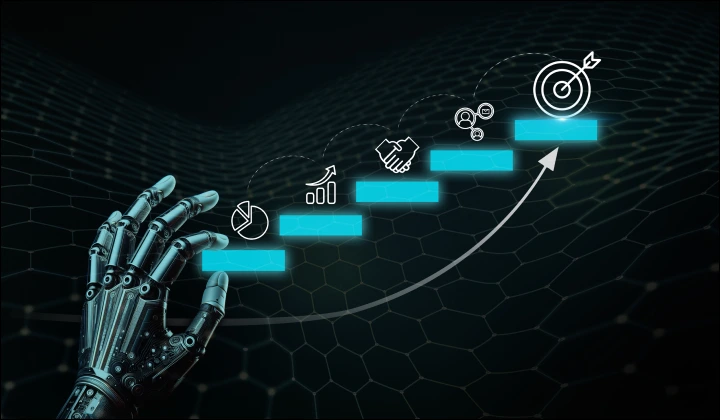The first month is about clarity, data readiness, and setting up the environment where agents can eventually thrive.
Agentic AI Roadmap: 90-Day Plan to Integrate AI into Your Software

Week 1 – Define the Vision & Strategic Alignment
Objective: Align stakeholders and pinpoint high-impact workflows for agentic AI in your product.
Stakeholder Workshops
Bring together product managers, engineering leads, data architects, compliance officers, and even a couple of key customers.
The purpose: define what agentic AI means for your product and where it aligns with business goals.
Opportunity Mapping
Use frameworks like value vs. feasibility to shortlist high-impact workflows:
→ Customer support ticket routing.
→ Automated analytics report generation.
→ Fraud detection across transactions.
→ Workflow orchestration (e.g., supply chain or HR processes).
Business Alignment
Define success in business terms: reduced time-to-resolution, increased engagement, operational cost savings, etc.
Output
✔️ A Vision Document with top workflows, success metrics, and clear stakeholder alignment.
✔️ Consensus among stakeholders on the first set of agentic AI pilots.
Week 2 – Product & Data Assessment
Objective: Identify product modules and data sources that agents can use, and evaluate the feasibility for integration.
Product Audit
→ List all existing modules, features, and APIs.
→ Identify which modules can expose “tools” for agentic AI to act on (e.g., internal APIs, workflow endpoints).
→ Note any technical constraints (rate limits, authentication, data sensitivity).
Data Audit
Categorize data sources:
→ Structured: Databases, transaction logs.
→ Unstructured: PDFs, manuals, chat logs.
→ Semi-structured: JSON APIs, spreadsheets.
Data Quality Scoring
Evaluate freshness, completeness, and accuracy. Example: customer interaction logs might be valuable but noisy.
Compliance Consideration
Map applicable laws (GDPR, HIPAA, SOC2, PCI DSS). Decide what data can be used for grounding agents.
Output
✔️ Data Readiness Report: Lists all sources, quality ratings, and accessibility.
✔️ Integration Map: Shows which modules and data can feed into agentic workflows.
✔️ Clear List of Blockers and Actions: Required to prepare product for agentic AI prototyping.
Week 3 – Capability Mapping & Technical Blueprint
Objective: Define agent roles, choose frameworks, and create a reference architecture for implementation.
Agent Role Definition
Decide whether you need:
→ Advisor: Makes recommendations.
→ Operator: Executes tasks via APIs.
→ Coordinator: Manages multi-step workflows.
→ Innovator: Generates new solutions or automations.
Framework Decision
Evaluate LangChain, CrewAI, n8n, Semantic Kernel, or a custom orchestration layer. Choose based on scalability, tool integration, and team familiarity.
Architecture Draft
Define how agents interact:
RAG pipeline → For contextual grounding.
Tooling layer → APIs, internal services.
Reasoning layer → Decision logic, memory.
Monitoring & safety → Logging, escalation.
Output
✔️ Reference architecture diagram for agentic AI.
✔️ Role-to-workflow mapping.
✔️ Framework selection and dependency backlog for Phase 2.
Week 4 – Sandbox Environment Setup
Objective: Prepare a controlled environment where agents can be developed and tested safely.
Infrastructure Setup
→ Set up a cloud environment (AWS, GCP, or Azure) for sandbox experiments.
→ Ensure LLM API access (OpenAI, Anthropic, or open-source models).
Vector Database Integration
→ Choose vector DB (Pinecone, Weaviate, Milvus, pgvector).
→ Load initial sample datasets for agent experimentation.
Observability Basics
Integrate Langfuse for LLM tracing and Prometheus + Grafana for monitoring.
Pod Formation
→ Assign engineers, ML specialists, product managers, and designers to the “Agentic AI Pod.”
→ Define responsibilities and sprint cadence for prototyping.
Run Initial Experiments
→ Test basic API calls and RAG retrieval in the sandbox.
→ Validate connectivity and data access.
Output
✔️ Fully functional sandbox environment with access to product data.
✔️ Team aligned and ready to start prototyping.
✔️ Initial small-scale agent experiments are running successfully.
Month two is about moving from planning to building working agentic AI prototypes and validating them.
Week 5 – Use Case Selection & Prototype Specification
Objective: Pick high-value workflows and define detailed agent behavior for prototyping.
Select 1–2 Workflows
Choose from the shortlist: one internal (low risk), one customer-facing (higher impact). Example:
→ Internal: Agent that summarizes weekly logs for engineering managers.
→ Customer-facing: Agent that assists in support ticket triage.
Workflow Decomposition
Break each use case into steps (inputs → reasoning → actions → outputs).
KPI Definition
For example:
→ Accuracy of outputs (target >85%).
→ Latency (target <2 seconds per step).
→ User time saved or error reduction.
Output
✔️ Detailed prototype specification document.
✔️ KPIs are defined for measuring success.
✔️ Clear workflow decomposition for development.
Week 6 – Prototype Development
Objective: Build functional agents in the sandbox to test reasoning, action, and tool integration.
Build First Agents
Implement agents that can:
→ Pull context from vector DB.
→ Call APIs for specific actions.
→ Store short-term memory for multi-step reasoning.
Data Grounding
Connect agents to the vector database for contextual retrieval. Load product documentation, logs, FAQs, or other relevant content.
Prompt Engineering
Craft initial prompts for each agent role (Advisor, Operator, Coordinator). Test and refine prompts for accuracy and consistency.
Run Sample Scenarios
Validate that agents can complete tasks end-to-end in the sandbox. Record outputs, errors, and edge cases for refinement.
Output
✔️ Working prototype agents with initial reasoning and action capabilities.
✔️ Preliminary logs and performance data.
✔️ Feedback loop for prompt and workflow adjustments.
Week 7 – Guardrails & Evaluation
Objective: Ensure agents are safe, auditable, and measurable before wider testing.
Safety Features
→ Define role-based constraints for each agent.
→ Apply policy rules (e.g., financial limits, approval triggers).
→ Add escalation triggers if confidence scores fall below thresholds.
Evaluation Metrics
→ Track latency, task success rate, and error types (hallucination, API failures, logic gaps).
→ Record reasoning traces for explainability.
Validate Output Quality
→ Test agents on multiple edge cases and refine prompts or reasoning logic.
→ Ensure the agent’s output aligns with expected business outcomes.
Output
✔️ Agents with built-in safety and governance controls.
✔️ The monitoring and evaluation framework is ready for pilot testing.
✔️ Audit-ready reasoning traces.
Week 8 – Pilot Testing
Objective: Test agents with real users or internal teams to gather feedback and iterate.
Approach
→ Deploy to an internal team or small customer group. Limit scope to avoid risk.
→ Gather qualitative (trust, usability) and quantitative (task completion, time saved) data.
→ Refine prompts, add missing tools, retrain embeddings.
Output
✔️ Pilot report with metrics, user sentiment, and a refined backlog for scaling.

Accelerate Your Product with Intelligent AI Agents?
We design and deploy enterprise-grade agentic AI solutions.
The final phase of the agentic AI roadmap transforms prototypes into production-ready features with governance, scalability, and GTM readiness.
Week 9 – System Hardening
Objective: Make agentic AI workflows stable, scalable, and observable in production.
Optimize Scalability
→ Implement caching for frequent LLM queries.
→ Use batching where possible for API calls.
→ Consider hybrid model setups (local lightweight model + API LLM).
Stress Test the System
→ Simulate peak load and concurrent agent usage.
→ Identify bottlenecks in APIs, data retrieval, or orchestration.
Build Monitoring Dashboards
→ Track usage, latency, error rates, and cost per agent action.
→ Integrate alerting for failures or performance degradation.
Refine Infrastructure
→ Ensure sandbox setups can scale to production load.
→ Apply redundancy and failover mechanisms where critical.
Output
✔️ Scalable, production-ready pipeline for agentic AI workflows.
✔️ Live monitoring dashboards with alerting in place.
✔️ Bottlenecks identified and resolved.
Week 10 – UX & Interaction Refinement
Objective: Make the agentic AI experience smooth and seamless for users.
Interaction Modes
→ Co-pilot: Agent suggests, user approves.
→ Auto-pilot: Agent executes autonomously.
Transparency
→ Display reasoning steps and sources behind agent decisions.
→ Provide easy-to-understand explanations for non-technical users.
Feedback Loop
→ Allow users to rate outputs or flag incorrect actions.
→ Feed this feedback into retraining or prompt refinement.
Output
✔️ Intuitive, transparent, agentic AI features integrated into the product.
✔️ Feedback mechanism in place for continuous improvement.
Week 11 – Governance & Security
Objective: Ensure compliance, accountability, and safe autonomy for agents.
Implement Audit Trails
→ Log all agent decisions and actions for traceability.
→ Ensure logs can be queried for debugging and compliance checks.
Validate Security Model
→ Confirm authentication and authorization for agent-triggered actions.
→ Encrypt sensitive data in transit and at rest.
Perform Compliance Audit
→ Review adherence to relevant regulations (GDPR, HIPAA, SOC2, PCI DSS).
→ Document policies for agent autonomy and escalation triggers.
Output
✔️ Full governance framework for agentic AI operations.
✔️ Security and compliance validated for production release.
Week 12 – Launch Readiness
Objective: Deploy agents to production and prepare for adoption by customers and internal teams.
Final Deployment
→ Move agents from the sandbox to the production environment.
→ Verify all integrations, monitoring, and logging are operational.
Go-to-Market Enablement
→ Create training materials and documentation for internal teams.
→ Prepare customer-facing materials: demos, tutorials, and onboarding guides.
→ Define pricing or packaging strategy if agentic AI is a premium feature.
Establish Continuous Improvement Loop
→ Define cadence for retraining, prompt tuning, and new workflow rollout.
→ Track KPIs to measure impact and adoption post-launch.
End of 90 Days – What You Achieve
✔️ Technology: Agentic AI is integrated into your software product with monitoring and guardrails.
✔️ Business: Teams are trained, GTM is aligned, and value is measurable.
✔️ Users: Gain trusted, transparent AI-powered features that either assist (co-pilot) or act (auto-pilot).

Need Help Implementing Agentic AI in Your Product?
Get a custom 90-day implementation plan.
Top FAQs on Agentic AI Roadmap
1. What is agentic AI, and how does it differ from traditional AI?
Agentic AI refers to AI systems capable of autonomous decision-making and executing multi-step workflows. Unlike traditional AI, which mainly provides predictions or suggestions, agentic AI can act on data, interact with tools, and manage tasks without constant human supervision.
2. How can I implement agentic AI in an existing software product?
Start by identifying high-value workflows, assessing your data readiness, and defining agent roles. Then, build prototypes in a sandbox environment, pilot them with internal teams or early customers, and finally scale to production with monitoring, governance, and user-friendly interfaces.
3. What are the benefits of agentic AI for enterprise software?
Agentic AI improves efficiency, reduces repetitive tasks, and provides actionable insights. It enhances workflow automation, decision-making, and customer experiences while enabling teams to focus on higher-value work.
4. How long does it take to integrate agentic AI into a product?
A structured approach can achieve production-ready agentic AI in approximately 90 days. This includes vision alignment, prototyping, pilot testing, system hardening, and production deployment.
5. What tools and frameworks are best for agentic AI implementation?
Common frameworks include LangChain, CrewAI, and Semantic Kernel. For data grounding, vector databases like Pinecone, Weaviate, Milvus, or pgvector are used. Orchestration layers connect agents to APIs, tools, and knowledge sources.
Glossary
1️⃣ Agentic AI: AI capable of autonomous decision-making, multi-step reasoning, and task execution with minimal human supervision.
2️⃣ (Retrieval-Augmented Generation): A method where AI agents retrieve relevant data from knowledge bases or documents to provide accurate, context-aware responses.
3️⃣ Vector Database: A database designed to store embeddings (vector representations of data) for semantic search and AI reasoning, e.g., Pinecone, Weaviate, Milvus, pgvector.
4️⃣ Sandbox Environment: A controlled testing environment where agentic AI prototypes are developed and validated without impacting production systems.
5️⃣ Prompt Engineering: The process of designing and refining AI prompts to guide agents toward accurate, contextually relevant outputs.


 11 mins
11 mins











 Talk to Our
Consultants
Talk to Our
Consultants Chat with
Our Experts
Chat with
Our Experts Write us
an Email
Write us
an Email





